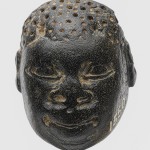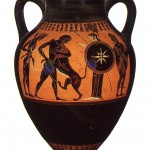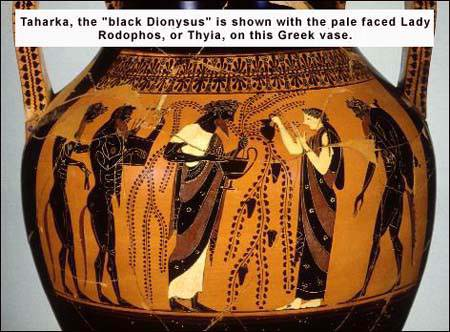
By Jide Uwechia with cited sources
The Benin Haplogroup or Haplogroup 19 Common in Africans, southern Greeks, Sicilians, and Albanians
There are at least four distinct African, (known as Senegal, Congo, Benin, Bantu Hbs Haplogroups) and one Asian chromosomal backgrounds (haplotypes) on which the sickle cell mutation has arisen.
The Benin haplotype (which originates from Nigeria, West Africa) accounts for HbS associated chromosomes in Sicily Northern Greece, Southern Turkey, and South West Saudi Arabia, suggesting that these genes had their origin in West Africa. The Asian haplotype is rarely encountered outside its geographic origin because there have been few large population movements and Indian emigrants have been predominantly from non HbS containing populations. Per:Graham R. Serjeant, MD, FRCP, The Geography Of Sickle Cell Disease:Opportunities For Understanding Its DiversityRSITY: http://www.kfshrc.edu.sa/annals/143/rev9239.html
Nigeria, west Africa appears the most logical origin of the sickle mutation in Greece evidence from beta S globin gene cluster polymorphisms (1991). It has been conclusively demonstrated that HbS in Greece is mostly haplotype #19 (the one that originated in Benin, Nigeria West Africa). See, Boussiou M, Loukopoulos D, Christakis J, Fessas P.; The origin of the sickle mutation in Greece; evidence from beta S globin gene cluster polymorphisms. Unit for Prenatal Diagnosis, Laikon Hospital, Athens, Greece.
Additionally, previous data suggest that the S/Bantu haplotype (from Southern Africa) is heterogeneous at the molecular level. Recent studies also report a similar heterogenity for the Benin Haplogroup. A study demonstrated the presence of the A -499 TA variation in sickle cell anemia chromosomes of Sicilian and North African origin bearing the S/Benin haplotype (from Nigeria). Being absent from North American S/Benin chromosomes, which were studied previously, this variation is indicative for the molecular heterogeneity of the S/Benin haplotype. Am. J. Hematol. 80:79-80, 2005.
A study was done in Albania (which borders Greece) relating to sickle cell anemia, sickle cell beta-thalassemia, and thalassemia major in Albania. The focus of the study was the characterization of sickle cell mutations. As one would expect, it was shown that the HbS mutation in the Albanian sample is the Benin (Nigeria)-originating haplotype #19. See, Boletini E, Svobodova M, Divoky V, Baysal E, Dimovski AJ, Liang R, Adekile AD, Huisman TH.; Sickle cell anemia, sickle cell beta-thalassemia, and thalassemia major in Albania: characterization of mutations. : Hum Genet. 1994 Feb;93(2):182-7.
According to a study done in 1973, before the availability of the advanced data cited above, “the occurrence of the sickle-cell trait in southern Europe …. is believed to reflect gene flow from the Middle East.” See A. P. GELPI, M.D, “Migrant Populations and the Diffusion of the Sickle-Cell Gene” August 1, 1973 vol. 79 no. 2 258-264 http://www.annals.org/content/79/2/258.abstract.
The problem with this 1973 study is that it assumes that the sickle cell genes came with the Arabs. Alas, updated research work has proven beyond doubt that the sickle cell genes proven to exist in southern Europe are exclusively Sickle cell gene Haplotype 19 or the Benin Sickle cell gene from Nigeria.
Y Haplogroup E-M78 and YAP In Black Africans and Greeks
Y Haplogroup E-M78 a derivative of E3B is a signature African gene as confirmed in research studies over the last few years. The high frequency of this haplogroup in Greece suggests the presence of a substantive African population in that region during prehistoric and historical time periods.
A recent paper has detected clades of haplogroups J and E3b that were likely not part of pre-historic migrations into Europe, but rather spread by later historical movements. Greeks .. [then there is] the marker J-M267, which may reflect more recent Middle Eastern admixture.
(Semino et al., Am J Hum Genet, 2004) E3b originates from East Africa while there is a high frequency of J-M267 in the East Coast of Africa as well as the Red sea coast of Arabia.
A recent sampling of the Greek population comprised 36 Peloponnesian samples, 5 of which were J-M172(xM12) and 17 of which were E-M78 (R.K., unpublished data).
In spite of the small Peloponnesian sample size, the high E-M78 frequency (47%) observed here is consistent with that (44%) independently found in the same region (Di Giacomo et al. 2003) for the YAP chromosomes harboring microsatellite haplotypes A. (Novelletto, personal communication) (Cruciani et al. 2004).
The study by by Di Giacomo et al. found the following African haplogroups in Greeks: Haplogroup A which is highly specific to West Africa, R1a, DE, and J2*(xDYS413= 18)J*(xJ2). R1* which probably gave rise to R1a is found in Northern Cameroon. DE is found principally among Nigerians and it is suspected that it originated from Nigeria. J is very prominent in East, and North Africa.
High-resolution Y-chromosome haplotyping and particular microsatellite associations reveal … an East Africa homeland for E-M78.Origin. See Ornella Semino, Chiara Magri, et al “Diffusion, and Differentiation of Y-Chromosome Haplogroups E and J: Inferences on the Neolithization of Europe and Later Migratory Events in the Mediterranean Area” http://www.pubmedcentral.nih.gov/articlerender.fcgi?tool=pubmed&pubmedid=15069642
HLA Genetic Relationship Between Ancient Greeks and Black Africans
HLA genes are reliable markers of past population movement and are still used in laboratories today to establish genetic inter-relationship amongst seemingly diverse peoples.
HLA genes in Macedonians and the sub-Saharan origin of the Greeks (2001) was a study conducted by Dr. Arniaz and other scholars in a top flying Spanish University. This study uses HLA genes to establish the African dimension of the roots of ancient Greece.
According to the Arniaz study, …Greeks are found to have a substantial relatedness to sub-Saharan (Ethiopian) people, which separate them from other Mediterranean groups. Both Greeks and Ethiopians share quasi-specific DRB1 alleles, such as *0305, *0307, *0411, *0413, *0416, *0417, *0420, *1110, *1112, *1304 and *1310. Genetic distances are closer between Greeks and Ethiopian/sub-Saharan groups than to any other Mediterranean group and finally Greeks cluster with Ethiopians/sub-Saharans in both neighbour joining dendrograms and correspondence analyses. The time period when these relationships might have occurred was ancient but uncertain and might be related to the displacement of Egyptian-Ethiopian people living in pharaonic Egypt. See Arnaiz-Villena A, et.al: HLA genes in Macedonians and the sub-Saharan origin of the Greeks. Tissue Antigens. 2001 Feb; 57(2): 118-27
There is a fraudulent claim (by those with idealogical investments in the topic) on the Internet that this study has been “retracted” or “refuted.” The study is perfectly valid. Sub-Saharan-specific and quasi-sub-Saharan-specific alleles were definitely detected in the Greek population at the DRB1 locus, and this is not open to question.
It would be helpful here to discuss the study that was retracted, and the reason why. It is the work titled: “The origin of Palestinians and their genetic relatedness with other Mediterranean populations” (which contained some cross-referenced Greek data in a neighbor-joining dendogram and a correspondence analysis) that was retracted. And it was retracted solely and strictly for political reasons, as this Observer article makes crystal clear:
http://www.guardian.co.uk/Archive/Article/0,4273,4307083,00.html
(Keep in mind we are dealing with the study on the relatedness of Jews and Palestinians at the moment, which was retracted, and not the one on the Greek-Black African relatedness, which was not retracted and remains valid. The two must not be confused.)
Appreciations to: http://onedroprule.org/about1071.html
Epilogue:
“Hb S is common in some areas of the Mediterranean basin, including regions of Italy, Greece, Albania and Turkey (Boletini et al., 1994) (Schiliro et al., 1990). Haplotype analysis shows that the Hb S in these areas originated in Africa. The genes probably moved along ancient trading routes between wealthy kingdoms in western Africa and the trade centers in the Mediterranean basin.” (Harvard University, http://sickle.bwh.harvard.edu/scdmanage.html)
“Usually, people with sickle cell disease outside Africa (e.g., blacks in the United States) or India have mixed haplotypes for their sickle cell genes.” (Harvard University, http://sickle.bwh.harvard.edu/scdmanage.html)
“Templeton gives a modern-day analogy: the presence of a gene for sickle cell anemia in Caucasians in Portugal. The gene traces back to a mutation that occurred in Africa and spread through interbreeding between Africans and Europeans. “The Africans didn’t come up, reconquer the Iberian peninsula, kill off all the Europeans, and that’s why there are sickle cell alleles in Portugal today,” he says. The presence of the sickle cell gene in Portugal “means that Portuguese and Africans have met and they’ve interbred, just like humans tend to do.” – “Out of Africa” – Ruth Flanagan, Contributing Editor, Earth Magazine, http://www2.mc.maricopa.edu/anthro/l…ofAfrica5.html




Dave
Kindly provide me the authority for this your quote:
“Such as Dr. Underhill states the E3B alpha cluster found in Europeans cannot be used as an index of black African ancestry….”
I want a link.
Second question: Is E3B alpha the only E Haplogroup extant in Europe? If no what are the other clusters? Please provide a link.
Finally, I repeat the UnderHill quotation for you to re-read:
“As mentioned before in relation to African NRY history, a Mesolithic population carrying Group III lineages with the M35}M215 mutation expanded northwards from sub-Saharan to north Africa and the Levant.â€
You mean you cannot see it still??? Give it Buddy. Don’t be specious.
Thanks
Jahdey
In all published literature this has *NEVER* been stated, especially in regards to E3b1-M78 alpha, which is simply a downstream M78 marker. That is Dr. Underhill OWN words, buddy, so I suggest you give it a rest.
“It cannot be used as an index of black african ancestry. Every non-african person traces ancestry to Africa.” ~P. Underhill
Underhill has always been of the belief that Greeks were of European Caucasian origins, not black Africans as proven by what he says in this article regarding some “Lebanese Christians are descendents of Crusaders and points to a genetic connection to the Crusaders,”:
“Peter Underhill is a senior research scientist at Stanford University who has previously analyzed Y chromosomes to study human migrations out of Africa.
Christians were established and converting “locals” in the Middle East prior to the arrival of the Crusaders, Underhill pointed out. The Greeks also had a pre-Crusade presence, so the chromosome match could have come from Greece rather than France or England.”
http://news.nationalgeographic.com/news/2008/03/080328-crusaders-dna_2.html
Meaning the chromosome match between Greece, France and England are the same. Also learn what they mean when they say “NRY history”, its not what you think.
“Thus, it appears that, in Europe, the overall frequency pattern of the haplogroup E-M78, the most frequent E3b haplogroup in this region, is mostly contributed by a new molecular type that distinguishes it from the aboriginal E3b chromosomes from the Near East.” Am. J. Hum. Genet., 74:1014-1022, 2004
So not only haplogroup E-M78 cannot be used as an index of black African ancestry but its also different from the aboriginal E3b chromosomes from the Near East. No where does any genetic scientist ever claim the E3B alpha cluster found in Europeans is an index of black African ancestry. That is only found in the delusional minds of Afrocentric.
E3B is divided into many clusters by such markers as M35; M78;
Haplogroup E3b (M35) appears to have originated in East Africa, but has been carried from there to the Near East and then on to North Africa and Europe. Today it is most common in the horn of Africa, North Africa, the Near East and around the Mediterranean. One subgroup decreases in frequency from SE to NW Europe consistent with a dispersal mediated by the arrival of farmers in the Neolithic period, beginning 10,000 years ago.
M35, the marker which defines the E3b group (strictly E3b1) and the most important downstream markers:
* V13 is the most common subtype of E3b found in Europe and indicates descent from Near Eastern farmers in the Neolithic period.
* V32 is a marker of East African ancestry, and is commonly found in Ethiopia and Somalia.
* V12 and V22 are also found in Europe, but are rarer than V13 and also found in N Africa and E Africa (V22).
* M78* chromosomes originate in NW Africa, although movement to Italy has brought small numbers to Europe.
* M81 is a marker of the indigenous Berber people of North Africa, and has spread across the Straight of Gibraltar and to Southern Italy
* M123 and M34 are present on a lineage which originated in the Near East, but spread to East Africa and also to Sicily.
And if you notice like I have been saying all along the * V13 down stream marker is the most common subtype of E3b found in Europe and indicates descent from NEAR EASTERN farmers in the Neolithic period, not black Africans. Like I said before European lineages are derived from “Central Asian†Paleolithic haplogroup R , yet no one calls R lineages in Europe Central Asian. Geneticists recognize that the precursor to European and Near Eastern E3b1 lineages lie in East Africa, yet they do *NOT* over-emphasize it to the point of calling every E3b1 clade and cluster “black Africanâ€, “Africanâ€, East African and or “African Neolithicâ€, because they all have different histories as well as being phylogeographically located and distributed differently.
Dave
V13 is the most common type in Europe and moved to Europe from Middle East. But who are the Middle Easterns, the write up shows you that E3B-V13 moved from Africa to Middle East….i.e. the Natufians.
V12 and V22 are also in Europe (from Africa), or did you go daft upon being confronted with that evidence?
M78 is a marker found predominantly in tropical Africa but which also exists in Europe.
M81 is all over North West Africa including Morocco, Niger, Nigeria, Senegal, Mauritania, Mali, and Cameroon. It is also found throughout southern Europe like Spain, Portugal, Greece, Malta, and Sicily.
Dave where are you from???
Genetics has no colour. Africans are not Blacks. Neither Europeans white. Those terms are false and misleading and have trapped you in a gloomy world of racialism.
Africans are phenotypically brown skinned people. Europeans are pink skinned people.
It has been demonstrated that two brown skinned people can make a pink skinned man like you but two pink skinned people like you could never make a brown skinned person.
More Genetics Lesson will follow if you dare to make yourself look more ignorant.
Jahdey
The one who is making himself look ignorant here is you, who continues with this Afrocentric fallacy that these markers show ‘black African lineage’. Incorrect. Near Easterners does not mean black African lineage. This is why in all published literature it has never been stated as such, especially in regards to E3b1-M78 alpha, which is simply a downstream M78 marker, that E3b show’s black African lineage .
The haplogroup that arose ca. 18.6 kya after the spread of E1b1b1* (M35) from the Horn of Africa to Egypt and has been further divided into subclades by Fulvio Cruciani, on the basis of the following SNP mutations is as follows.
E1b1b1a1 (V12*) The oldest sub-clade, found mainly in Southern Egyptians (arose ca. 15.2 kya); formerly comprised a few of Cruciani’s delta cluster.
E1b1b1a1a (V32*) Prevalent in the Horn of Africa among Somalis, Ethiopians, and Eritreans; formerly defined as the gamma cluster (arose ca. 8.5 kya).
E1b1b1a2 (V13*) The most prevalent clade among Europeans; first arose in West Asia ca. 11.5 kya, and equivalent with Cruciani’s alpha cluster.
E1b1b1a3 (V22*) Prevalent in Northeast Africa and Egypt, with higher microsatellite variance (0.35 vs. 0.46, respectively) in Egypt, comprising most of those classified in Cruciani’s earlier delta cluster.
V12 and V22 are found in N Africa and E Africa but are very RARE in Europe and show recent migration to the region.
Incorrect: Haplogroup E-M81 is localized in NW Africa (highest frequency 80% in Mozabite Berbers, and more than 50% in several populations of the region). In general regarding Europe, it appears that this marker occurs at very small frequencies less then 5% in the West and Central Mediterranean region of Europe with the exception of the southern Portuguese where its frequency is somewhat elevated. It is not found in the Balkans (Rumania, Bulgaria, Albania, Greece, Croatia) or elsewhere in Europe.
(M81); formerly E3b1b, E3b2
E1b1b1b: The most common Y chromosome haplogroup in North Africa. Colloquially referred to as the “Berber marker” for its prevalence among Mozabite, Moyen Atlas, Kabyle and other Amazigh groups. Also quite common among North African Arab groups. Reaches frequencies of up to 80% in the Maghreb.
“Africans are phenotypically brown skinned people. Europeans are pink skinned people.”
One thing we seem to agree on, which is why Southern Europeans are not Africans aka phenotypically brown skinned people but EUROPEANS aka phenotypically pink skinned people.
Dave
I cannot understand your mindless babble it makes no sense. Please cite scientists when you write, I can no longer endure your pink drivel.
Here is what real genetists have to say:
On the basis of the previously published phylogeny (Y Chromosome Consortium 2002; Jobling and Tyler-Smith 2003), the mutations M2/P1/M180, on the one hand, and M35/M215, on the other, further subdivide E3 in two monophyletic haplogroups: E3a and E3b. Both haplogroups are frequent in Africa (Underhill et al. 2000; Cruciani et al. 2002), although, to date, only E3b has also been observed in Europe (Semino et al.2000) and western Asia (Underhill et al. 2000; Cinniog? luet al. 2004).